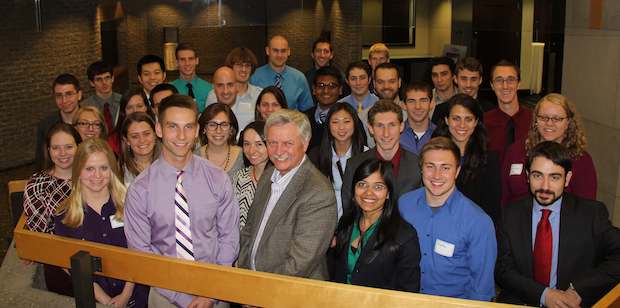

ACerS president David Green—a materials scientist by training—speaks to the President’s Council of Student Advisors in Montreal, most of whom are materials scientists in training. What makes any of them ceramic engineers? (Image above: Richard Brow, then ACerS president, with the PCSA in Montreal 2013.) Credits: ACerS.
ACerS president David Green is not a ceramic engineer. He holds a BS in chemistry and BS, MS, and PhD degrees in materials science. He describes his undergraduate MSE degree as a metallurgy curriculum with a polymers course added in. No ceramics.
In fact, he told me in a recent interview that he did not encounter ceramics until he started graduate school, and then only because there were no metallurgy projects on the topic that interested him the most—fracture. Instead, a metallurgy professor directed Green to a guy down the hall who had a project on fracture, but fracture of ceramics. “And I said, ‘Ceramics? What the heck are ceramics?’“ Green recounts with a laugh.
Green was accepted on the project to study fracture of zirconia. “I didn’t know anything about ceramics. I didn’t know anything about zirconia, but it was fracture, so—OK. I can count very closely to the day when I started my ceramic career. It was when I took on this project with Dr. Pat Nicholson and started working on fracture of zirconia at McMaster University in Canada. That’s how I got involved in ceramics,” he recalls.
Clearly, Green has identified himself as a ceramic engineer and scientist ever since that auspicious start. To me, the story begs the question—What is a ceramic engineer? (This includes glass scientists, too, of course.)
I am a ceramic engineer. I base my claim on two diplomas stating as much and my having worked as a glass researcher for a few years a long time ago. Green, on the other hand, has worked on ceramic materials his entire working career, even though his diplomas are in the more general field of materials science.
As surely as oxidation persists, ceramic and glass materials will be here to stay. However, ceramic engineering programs are not. In the United States, for example, most ceramic engineering and metallurgy programs have been absorbed into materials science and engineering departments. The Society was founded 115 years ago to meet the professional needs of those who worked on ceramic and glass materials. At the time of ACerS founding in 1898, only one ceramic engineering program existed in the US—Ohio State University’s five-year old Clay-Working and Ceramics Department. Evolution has brought us to a similar situation, and today the Society has a similar mission.
So, what makes someone a ceramic materials engineer or scientist?
How about this list?
A ceramic engineer
· Works on materials that are inorganic and nonmetallic
· Works on functional and structural materials (as opposed to condensed matter, for example)
· Is multidisciplinary, often working at the intersection of two fields such as materials and electronics or construction or biomedicine. This includes the intersection of material families, such as metals and ceramics.
· Is an enabler (refractories, for example, enable process metallurgy, heat treating, etc.)
· Is unique, specialized, smart, different, a team player, rare.
What do those of us who call ourselves ceramic or glass engineers and scientists think it takes to be one of us? What does it take to know enough about ceramics or glass to claim the expertise?
I want to know what you think.
What is a ceramic engineer? What makes YOU a ceramic engineer?
Author
Eileen De Guire
CTT Categories
- Education
Related Posts
Ohio Creativity Trail: Heisey Glass Museum
January 13, 2026
Celebrating the US Semiquincentennial: Ohio Creativity Trail
December 16, 2025


